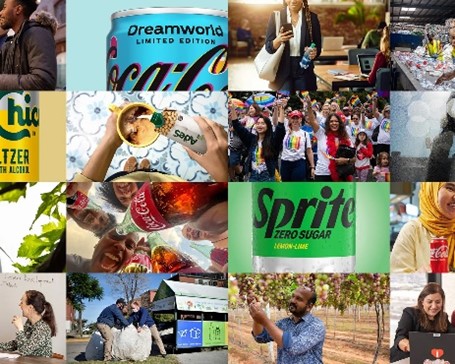The Consumer-Packaged Goods (CPG) industry occupies a unique space, balancing convenience with environmental responsibility. Our everyday lives are filled with CPG products, from food and beverages to personal care items and household essentials. However, the traditional linear " take-make-dispose " model has resulted in a growing waste crisis characterized by overflowing landfills and dwindling resources.
The CPG industry is a primary source of consumer goods but has a significant environmental impact. This blog post examines how CPG brands embrace circular economy principles like recycling and reuse to minimize waste and create a more sustainable future. We'll explore how these efforts can make a closed-loop system for resource management within the CPG industry.
The CPG Industry and the Looming Waste Challenge
The CPG industry faces a significant environmental impact. Here’s a closer look at some of the challenges:
- Packaging Waste: The extensive use of plastic packaging throughout the Consumer-Packaged Goods (CPG) industry presents a significant environmental challenge. While plastic serves the purpose of protecting and preserving products, its reliance has resulted in vast amounts of plastic waste accumulating in landfills and oceans. This growing problem of plastic pollution harms wildlife and disrupts ecosystems.
- Food Waste: According to the Food and Agriculture Organization (FAO), a significant portion of our global food supply is lost or wasted annually. Estimates suggest roughly one-third of all food produced globally never reaches consumers, translating to a staggering ton of food wasted annually. This represents a significant loss of resources and a major contributor to greenhouse gas emissions within the CPG industry. Food waste can occur at various stages, from farming to processing to retail and finally at the consumer level.
- Resource Depletion: The production of CPG goods often relies heavily on virgin resources like water, wood pulp, and fossil fuels. A circular approach can help conserve these vital resources for future generations. For instance, producing paper products requires significant amounts of water and wood pulp. Circularity encourages using recycled paper content, minimizing the need for virgin resources.
As these challenges indicate, there is an urgent need for a shift from traditional waste management practices to more sustainable solutions.

From Recycling to Circularity: A Spectrum of Sustainability Efforts
In response to these challenges, CPG companies are implementing various strategies to address the waste problem:
- Recycling: Many companies are increasing the use of recycled content in their packaging. This reduces reliance on virgin materials and diverts plastic waste from landfills. For example, Nestlé: With a focus on reducing packaging waste and increasing recycled content, Nestlé is one of the key players in the circularity movement. Nestle aims to achieve 100% recyclable or compostable packaging by 2025. Notably, they’ve partnered with waste management companies to develop innovative recycling technologies, promoting circularity throughout the value chain. This ambitious goal signifies a shift towards a more circular approach within the beverage industry.
- Refill and Reuse Systems: Some brands are exploring refill and reuse models, encouraging consumers to reuse containers instead of discarding them after a single use. For example, The Body Shop, this famous personal care brand, offers refill pouches for select shampoo and conditioner products, reducing packaging waste by up to 75% compared to traditional packaging. This initiative exemplifies the potential of refill and reuse models within the CPG industry.
- Compostable Packaging: Compostable packaging options are gaining traction as a sustainable alternative to traditional plastic packaging. These packaging materials are designed to decompose naturally under specific conditions, minimizing their environmental impact. For example, Unilever is a global leader in sustainability and is setting ambitious circularity goals. Unilever aims to halve its virgin plastic use by 2030 and achieve 100% recyclable or compostable packaging by the same year. Additionally, its commitment to sustainable sourcing and exploring refill and reuse models further solidifies its position as a frontrunner in circularity.
These efforts represent a shift towards more holistic sustainability practices within the CPG industry.

Embracing Circularity: A Holistic Approach for a Sustainable Future
The circular economy goes beyond just recycling and reuse. It’s a systemic shift towards resource management, aiming to keep materials and products in use for as long as possible. Here’s how CPG companies can embrace circularity:
- Product Design: It is crucial to design products for durability, repairability, and recyclability. This extends the lifespan of products and facilitates their reintegration into the system at the end of their use. Example: ZWS Essentials (Zero Waste Store), a company focused on personal care products, offers a refillable and reusable razor system with replaceable blades, significantly reducing waste generation compared to disposable razors.
- Sustainable Sourcing: Sourcing materials from responsibly managed forests and using recycled content in packaging are essential steps towards circularity. Example, Seventh Generation (Cleaning Products): This company uses plant-based ingredients and recycled materials in their cleaning products. Seventh Generation exemplifies the importance of sustainable product formulation within the circular economy.
- Extended Producer Responsibility (EPR): EPR incentivizes companies to design products for recyclability and invest in take-back programs, promoting a more circular approach. The European Union (EU) has implemented a comprehensive EPR framework for various packaging materials, driving innovation in sustainable packaging design.

Several other companies are emerging as pioneers in circular practices, paving the way for a more sustainable future. Here are some examples:
- Ellen MacArthur Foundation: This influential organization plays a critical role in advocating for the circular economy within the CPG industry. Their “New Plastics Economy” initiative equips brands with valuable resources and guidance, encouraging a shift from single-use plastics to a more circular approach.
- TerraCycle (Recycling Solutions): A game-changer in waste management, TerraCycle offers innovative recycling solutions for traditionally non-recyclable materials. They partner with brands and consumers to collect and repurpose waste into new products, promoting a more circular approach to resource management.
- Hello Products (Oral Care): Hello Products prioritizes sustainability by utilizing recycled plastic packaging and offering refillable options for some oral care products. Their commitment to recycled content and refill models showcases a multi-faceted approach to circularity.
- Ben & Jerry’s (Ice Cream): This iconic ice cream brand has pledged to transition their packaging to compostable by the end of 2022. Their efforts demonstrate the potential for innovative packaging solutions within the food and beverage sector.
- M&S: Marks & Spencer, a leading UK retailer, has implemented various circularity initiatives. These include offering reusable packaging options for certain products, exploring food waste reduction strategies, and collaborating with brands that prioritize sustainable practices. M&S exemplifies retailers’ role in fostering a circular CPG industry.
- Coca-Cola, a leading beverage company, has set a goal of using 50% recycled PET plastic in all its packaging by 2030.
As these examples show, the shift towards circularity is gaining momentum across the industry, but it is not without challenges.

Challenges and Opportunities for a Circular CPG Industry
The journey towards a circular CPG industry necessitates navigating some key challenges:
- Consumer Behavior: Shifting ingrained consumer habits requires a multi-pronged approach. Educating consumers about responsible consumption and the advantages of refill and reuse models is crucial. CPG brands can play a vital role in driving this behavioral change. Clear labeling that outlines recycling information and highlights the use of recycled content is essential. Additionally, transparent communication about sustainability efforts and marketing campaigns emphasizing the environmental benefits of circular choices can encourage consumers to embrace these practices.
- Infrastructure Investment: Effective circular systems rely heavily on robust collection, sorting, and recycling infrastructure. Investments in innovative recycling technologies are paramount to enhance resource recovery. Collaboration between governments, waste management companies, and the CPG industry is critical to developing a solid infrastructure that underpins a circular economy.
- Policy and Regulation: Supportive government policies are instrumental in incentivizing circular practices and deterring waste generation. Policy measures such as Extended Producer Responsibility (EPR) schemes that hold producers financially responsible for product end-of-life management, bans on single-use plastics, and tax breaks for companies utilizing recycled content can create a regulatory environment that fosters circularity within the CPG industry.
The CPG industry has a unique opportunity to drive positive change. Here’s how CPG brands and consumers can contribute:
For CPG Brands:
- Invest in circular design: Develop long-lasting, repairable, and easily recyclable products. Explore innovative materials and packaging options that minimize environmental impact. For instance, Patagonia, a renowned outdoor apparel company, incorporates recycled materials whenever possible, reducing its reliance on virgin resources.
- Implement refill and reuse models: Offer consumers options to refill containers or reuse packaging, minimizing waste. Partner with retailers to create refill stations or incentivize reuse programs through loyalty initiatives. The Body Shop, a famous personal care brand, offers refill pouches for select shampoo and conditioner products, reducing packaging waste by up to 75% compared to traditional packaging.
- Increase transparency and communication: Educate consumers about your circularity initiatives and the environmental benefits. Clearly label packaging with recycling information and highlight the use of recycled content. Consumers are increasingly looking for brands prioritizing sustainability, and transparency is critical to building trust.
- Collaborate with stakeholders: Work with retailers, waste management companies, and policymakers to build a comprehensive circular economy framework. Engage in collaborative efforts to improve recycling infrastructure and develop innovative waste management solutions. Collaboration across the value chain is essential for achieving a circular CPG industry.
For Consumers:
- Make informed choices: opt for products with minimal packaging or those made from recycled materials. Look for brands committed to sustainability and circularity practices. By seeking sustainable options, consumers can send a powerful message to CPG companies that there is a demand for change.
- Embrace reuse and refill systems: Participate in brand refill programs, reducing single-use packaging waste. Consider refillable water bottles and reusable shopping bags, and opt for durable and reusable packaging products. Small changes in consumer behavior can collectively make a significant impact.
- Reduce food waste: Plan your meals, purchase only what you need, and practice proper storage to minimize food waste at home. Compost food scraps whenever possible to divert organic waste from landfills. The FAO estimates that food waste reduction is essential to achieving food security for a growing global population.
- Advocate for change: Support brands prioritizing sustainability and urge policymakers to enact circularity-focused regulations. Spread awareness about the importance of circularity and encourage others to adopt sustainable consumption habits. Collective action is vital to building a more sustainable future for the CPG industry.

Conclusion
Building a circular CPG industry requires a collective effort. By embracing recycling, reuse, and the principles of circularity, CPG brands can minimize waste, conserve resources, and create a more sustainable future. As consumers, we can play a vital role by making informed choices, embracing responsible consumption habits, and supporting brands committed to circularity. Together, we can transform the CPG industry into a responsible leader in environmental stewardship.
Talk to One of Our Experts
Get in touch today to find out about how Evalueserve can help you improve your processes, making you better, faster and more efficient.


